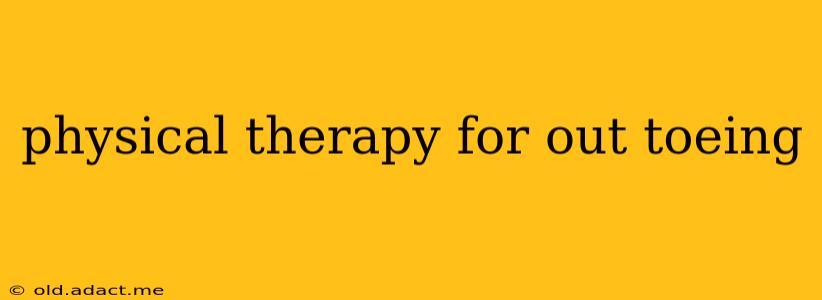Out-toeing, also known as external tibial torsion, is a condition where the feet turn outwards excessively when walking or standing. While often a benign developmental issue, it can sometimes contribute to gait abnormalities, knee pain, and other musculoskeletal problems. Physical therapy plays a crucial role in addressing out-toeing, particularly in children and adolescents, by improving foot alignment and overall biomechanics. This comprehensive guide explores the various physical therapy approaches used to correct out-toeing and enhance lower limb function.
What Causes Out-Toeing?
Understanding the underlying cause of out-toeing is essential for designing an effective treatment plan. Several factors can contribute, including:
- Developmental Factors: In many cases, out-toeing is a normal developmental variation that resolves on its own as a child grows. The bones and muscles of the legs are still developing, and slight asymmetries are common.
- Metatarsus adductus: This is a common foot deformity where the forefoot turns inward. While not directly out-toeing, it can sometimes be associated with a compensatory outward rotation of the lower leg.
- Femoral anteversion: This is an inward twisting of the thigh bone (femur) that can cause the feet to turn outward.
- Tibial torsion: This refers to the twisting of the tibia (shin bone). External tibial torsion is the specific cause of out-toeing.
- Underlying medical conditions: In rare cases, out-toeing can be a symptom of neuromuscular conditions or other medical issues.
What Physical Therapy Techniques Are Used to Treat Out-Toeing?
Physical therapy for out-toeing aims to improve muscle strength, flexibility, and overall joint alignment. Common techniques include:
- Stretching Exercises: These focus on lengthening tight muscles, particularly those in the hips and inner thighs, that might be contributing to the outward rotation of the legs. Examples include hip flexor stretches, inner thigh stretches, and piriformis stretches.
- Strengthening Exercises: Strengthening exercises target the muscles responsible for proper hip and leg alignment. This often includes strengthening hip abductors (muscles that move the leg away from the body) and external rotators (muscles that rotate the leg outward).
- Proprioceptive Exercises: These exercises improve balance and coordination, helping the individual to maintain proper foot placement and gait pattern. Examples include single-leg stances, balance board exercises, and agility drills.
- Manual Therapy: A physical therapist may use manual techniques, such as soft tissue mobilization and joint mobilization, to improve joint mobility and reduce muscle tension.
- Orthotics: In some cases, custom orthotics may be recommended to support the feet and ankles and help correct the foot alignment. These are typically used in conjunction with other physical therapy interventions.
- Gait Training: This involves working on the individual's walking pattern to improve efficiency and reduce stress on the joints. The therapist may provide cues and guidance to correct the outward rotation of the feet during walking.
How Long Does Physical Therapy Take for Out-Toeing?
The duration of physical therapy for out-toeing varies depending on the severity of the condition, the individual's age, and their response to treatment. Some children may see improvement within a few weeks, while others may require several months of therapy. Regular adherence to the prescribed exercises and diligent home practice are crucial for successful outcomes.
Does Out-Toeing Affect Gait?
Yes, out-toeing can significantly affect gait. The outward rotation of the feet can lead to an altered walking pattern, potentially causing increased stress on the knees, hips, and lower back. This can contribute to pain and discomfort, and over time may lead to degenerative joint changes.
What Are the Long-Term Effects of Untreated Out-Toeing?
While mild out-toeing often resolves naturally, untreated severe cases can lead to long-term musculoskeletal problems. These include:
- Knee pain: Abnormal stress on the knee joint.
- Hip pain: Altered hip mechanics can lead to pain and dysfunction.
- Back pain: Compensatory movements to accommodate out-toeing can strain the back.
- Increased risk of falls: Altered gait patterns can compromise balance and increase the risk of falls.
When Should I See a Physical Therapist for Out-Toeing?
If you or your child has significant out-toeing that is causing pain, gait abnormalities, or other concerns, consult a physical therapist. Early intervention is often key to achieving optimal results. A physical therapist can assess the condition, determine the underlying cause, and create a customized treatment plan to address the specific needs of the individual.
Disclaimer: This information is for educational purposes only and does not constitute medical advice. Always consult with a healthcare professional for any health concerns or before making any decisions related to your health or treatment.
